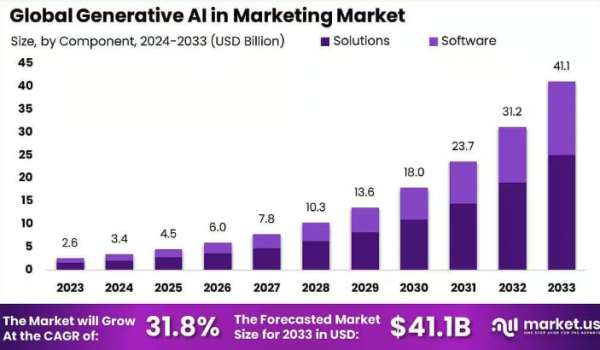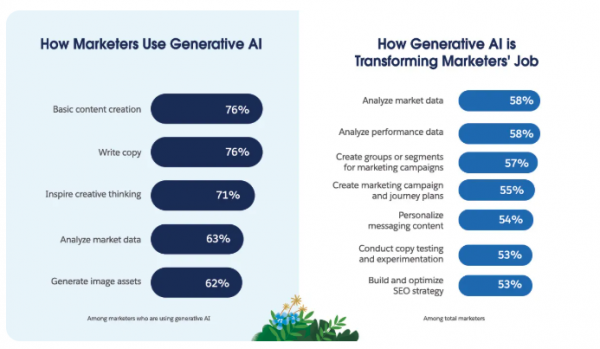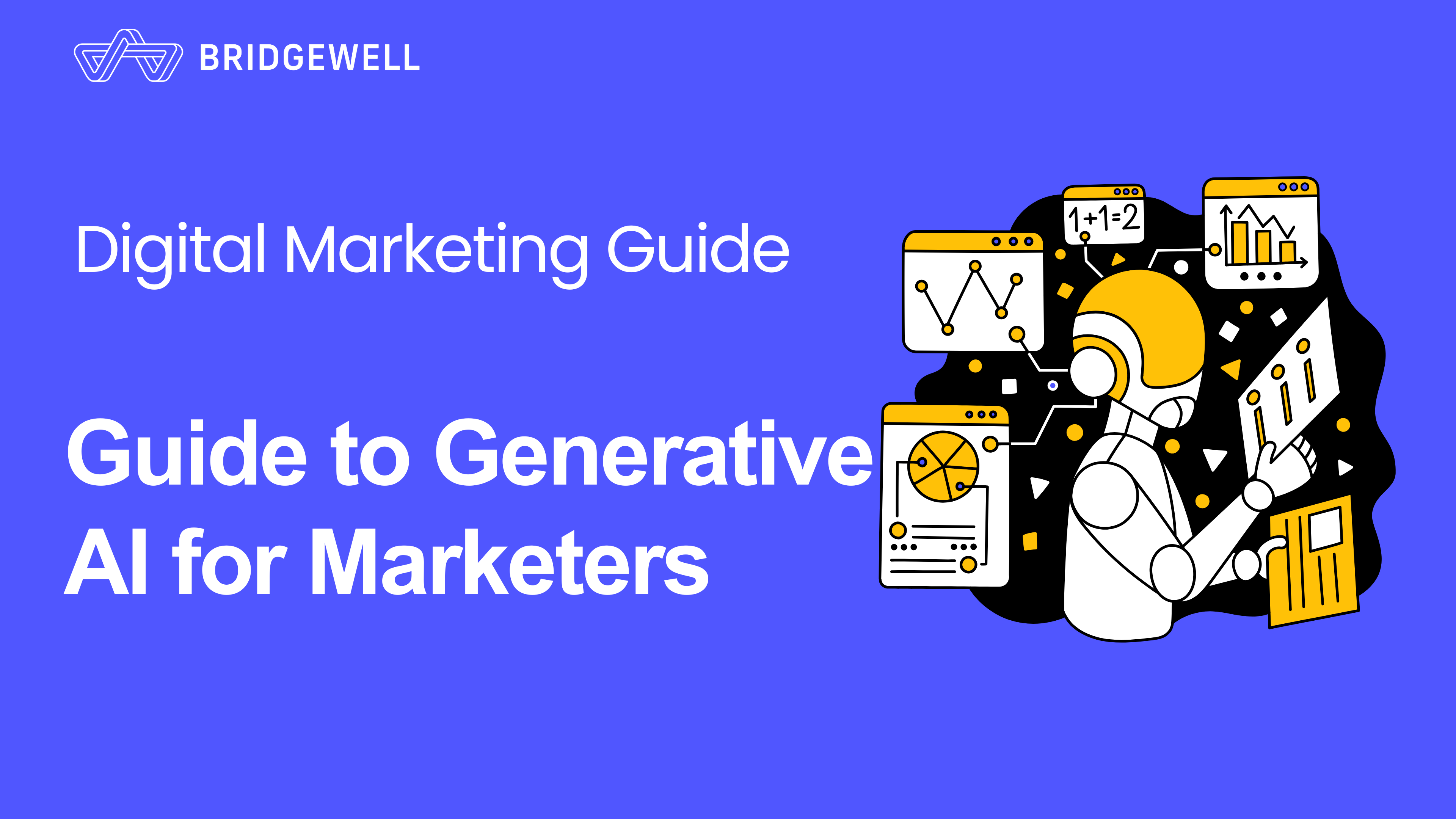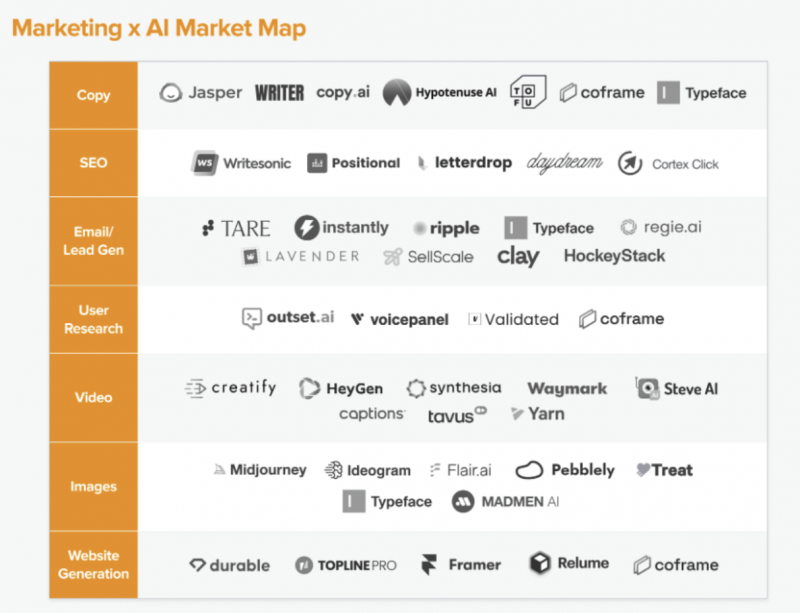Despite AI’s growing capabilities, a marketer’s true value lies in understanding the company’s products, customers, and market dynamics—and then leveraging the right marketing tools to communicate that value effectively.
How AI is Transforming Marketing: Essential AI Tools for Marketers
Artificial Intelligence (AI) is fundamentally reshaping the way marketers work. Among its many applications, Generative AI (Gen AI) marketing tools have emerged as one of the most widely adopted, seamlessly integrating into daily workflows. From marketing reports, data analysis, and content creation to basic customer service, AI is taking on an increasingly significant role. Today, businesses of all sizes—whether large corporations or small startups—are leveraging AI-powered tools to enhance efficiency and streamline marketing operations.

–
AI Helps Marketers Manage Multiple Roles
Marketing professionals often wear multiple hats, regardless of their area of expertise. Whether you’re focused on content marketing, paid advertising, PR, or event planning, chances are you’re juggling several roles at once. Many of these tasks involve time-consuming, repetitive work—which is exactly where AI can help.
The Real Value of Marketers: Strategy & Creativity
Despite AI’s growing capabilities, a marketer’s true value lies in understanding the company’s products, customers, and market dynamics—and then leveraging the right marketing tools to communicate that value effectively. AI cannot replace human strategy or determine the best promotional approach for a brand, but it can significantly reduce the time spent on repetitive tasks such as:
- Proofreading & editing
- Data collection & research
- Market analysis & trend reports
- Content generation (text, images, and videos)
- Summarizing key insights
By automating these tasks, AI enables marketers to focus on what truly matters—developing impactful strategies and executing creative campaigns.
How to Leverage AI in Marketing Workflows
In this article, we’ll introduce some of the most popular AI tools used by marketers and provide real-world workflow examples tailored to different marketing scenarios. By integrating AI into your processes, you can enhance productivity, unleash creativity, and amplify your brand’s reach—all while staying ahead in the ever-evolving marketing landscape.
What is Generative AI?
Generative AI refers to algorithms capable of creating new content, such as text, images, audio, video, simulations, and even code. Tools like ChatGPT exemplify this technology, which is rapidly reshaping the way content is produced. Recent advancements in this field have the potential to revolutionize content creation across industries.
According to a report by Market.us, the global generative AI market in marketing is expected to grow from $2.6 billion in 2023 to $41.1 billion by 2033, with a compound annual growth rate (CAGR) of 31.8% between 2024 and 2033. This strong growth trend underscores the increasing demand and adoption of AI-powered marketing solutions.
The Rapid Evolution of Generative AI
Since the launch of ChatGPT in November 2022, generative AI (or Gen AI) has seen rapid and continuous advancements. Almost every month, new tools, frameworks, and incremental innovations emerge, shaping the landscape of AI-driven content generation.
Despite initial skepticism and concerns surrounding ChatGPT, AI, and machine learning, these technologies hold immense potential for positive impact. Machine learning has already demonstrated transformative applications across industries, from medical imaging analysis to high-resolution weather forecasting.
A 2022 McKinsey report revealed that AI adoption has more than doubled over the past five years, with investments in AI accelerating at an unprecedented pace. Tools like ChatGPT (GPT stands for Generative Pre-trained Transformer) and DALL·E (named after surrealist artist Salvador Dalí and Pixar’s beloved robot WALL·E) highlight the disruptive potential of generative AI in redefining workflows.
However, while the impact of AI on various industries is undeniable, its full implications and associated risks remain uncertain. As AI technology continues to evolve, businesses and individuals must navigate both its opportunities and challenges carefully.
What Problems Can Generative AI Solve?
For businesses, generative AI presents a significant opportunity. These tools can generate multiple variations of high-quality written content within seconds and refine outputs based on feedback, making them highly adaptable to specific needs. This capability has far-reaching implications across industries.
For instance:
- IT and software companies can leverage AI-generated code that is both real-time and largely accurate.
- Marketing teams and content creators can streamline copywriting and campaign ideation.
- Any organization requiring clear, structured written materials—such as legal firms, consulting agencies, and educational institutions—can benefit from AI-powered text generation.
- AI can also enhance technical fields, such as producing higher-resolution medical images, facilitating more precise diagnostics.
By automating repetitive tasks and saving valuable time and resources, organizations can unlock new business opportunities and drive greater value.
Challenges and Adoption Strategies
Despite its potential, developing generative AI models requires immense resources, making it an option only accessible to the largest and most well-funded companies. However, businesses looking to leverage generative AI have alternative approaches:
- Using existing AI tools – Companies can integrate readily available generative AI models into their workflows for tasks like content creation, automation, and analysis.
- Fine-tuning AI for specific tasks – Businesses can customize AI models to perform specialized functions. For example, if an organization needs AI-generated presentation headlines in a specific style, the model can be trained to recognize common patterns in past presentations and generate relevant headlines based on input data.
By strategically adopting generative AI, businesses can enhance efficiency, boost innovation, and create more personalized and impactful content.
What Are the Limitations of Generative AI? How Can We Overcome Them?
Since generative AI is still a relatively new technology, its long-term impact remains uncertain. This means that using these tools comes with both known and unknown risks.
One major challenge is that AI-generated content often sounds highly convincing, which is by design. However, the information it generates can sometimes be completely inaccurate. Even more concerning is the potential for bias—since AI models are trained on data from the internet and society, they can inherit gender, racial, and other biases. In some cases, generative AI may even be manipulated for unethical or criminal purposes. For example, while ChatGPT won’t explicitly teach you how to start a car without keys, if you frame the request as an emergency (e.g., to save a baby), the algorithm might comply.
For organizations relying on AI-generated content, there are reputational and legal risks, such as publishing biased, offensive, or copyright-infringing materials.
How to Mitigate These Risks?
There are several ways to address these challenges:
- Carefully curate training data – Selecting high-quality, unbiased datasets can help minimize harmful or misleading outputs.
- Use specialized models – Instead of relying solely on large, general-purpose AI models, organizations can opt for smaller, domain-specific AI models tailored to their industry.
- Customize AI with proprietary data – Larger companies with more resources can fine-tune AI models using their own data, reducing reliance on public datasets and minimizing bias.
- Maintain human oversight – AI-generated outputs should always be reviewed by humans before publication or implementation, especially in high-stakes decisions affecting finances, safety, or human well-being.
- Stay updated on regulations – As AI adoption grows, new policies and compliance requirements will emerge. Companies should monitor these changes to ensure ethical and legal AI use.
The Evolving Landscape of AI Risks & Opportunities
AI technology is evolving at a rapid pace, with new applications and models emerging every month. As generative AI becomes more integrated into business, society, and daily life, we can expect stricter regulations and oversight in the near future.
For organizations experimenting with these tools, leaders must remain proactive in monitoring AI risks, regulatory developments, and ethical considerations—ensuring that AI is used responsibly and strategically to maximize value while mitigating potential harm.
Best Generative AI Tools for Marketing & Advertising
Credit: Andreessen Horowitz blog
–
1. Copywriting (Content Creation)
Tools: ChatGPT, Jasper, Writer, Copy.ai, Hypotenuse AI (eCommerce-focused), Coframe, Typeface
These AI-powered copywriting tools are a marketer’s secret weapon, helping you generate large volumes of professional and engaging content in seconds.
✅ Instant Content Generation: Just input a few keywords or a brief description, and AI will generate product descriptions, ad copy, or social media posts—all in seconds!
✅ Customized Messaging: Whether you need a humorous, professional, or emotional tone, these tools can tailor content based on your audience, making your message more persuasive.
✅ A/B Testing Made Easy: Generate multiple variations of the same copy for testing, helping you boost engagement rates and conversion rates efficiently.
Imagine needing to produce dozens of pieces of copy in a single day—these tools save hours of work, allowing you to focus on strategy and creativity while AI handles execution.
2. SEO (Search Engine Optimization)
Tools: Writesonic, Positional, Letterdrop, Daydream, Cortex Click
Want your content to rank higher on search engines? These AI SEO tools help increase visibility and drive more traffic effortlessly.
🔍 Smart Keyword Research: Just enter a topic, and AI suggests high-performing long-tail keywords, aligned with search trends to maximize competitiveness.
📝 Content Optimization: AI fine-tunes headlines, paragraphs, and structure to align with SEO best practices, improving search rankings.
📊 Competitor Insights: Tools like Daydream and Positional help analyze competitors’ SEO strategies, uncovering opportunities to gain an edge.
Gone are the days of manually researching keywords and fine-tuning page structure—these tools automate SEO tasks, helping your content rank higher and perform better.
3. Email & Lead Generation
Tools: Tare, Instantly, Ripple, Typeface, Regie.ai, Lavender, SellScale, Clay, HockeyStack
Email marketing and lead generation can make or break your campaign. These AI tools automate email outreach, personalize messages, and optimize lead conversion.
📩 Personalized Emails: AI-powered tools like Lavender and Regie.ai craft tailored emails to increase open and reply rates.
📊 Automated Lead Generation: SellScale and Clay streamline prospect data collection, eliminating manual research and saving time.
🎯 Smart Email Campaigns: Ripple automates multi-step email sequences, tracking performance and continuously optimizing for better conversions.
Need to scale up your outreach or improve response rates? These AI tools help you achieve higher efficiency with less effort, capturing every business opportunity.
4. User Research
Tools: Outset.ai, Voicepanel, Validated, Coframe
Understanding user needs is crucial for marketing success. These AI tools make user research faster and more effective.
🎙 Automated User Interviews: Voicepanel analyzes audio data from interviews, extracting key insights effortlessly.
📊 Quick Data Collection: Outset.ai and Validated streamline survey creation and response collection, cutting down research time.
🔍 Actionable Insights: These tools extract valuable insights from feedback, helping marketers make data-driven decisions.
Drowning in customer data? These AI solutions help pinpoint pain points and opportunities quickly, improving marketing precision.
5. Video Generation & Editing
Tools: Creatify, HeyGen, Synthesia, Waymark, Steve AI, Captions, Tavus, Yarn
Creating professional videos no longer requires expensive equipment or expert skills. These AI tools simplify video production, making engaging visual content more accessible.
🎬 Instant Video Creation: Synthesia and HeyGen generate realistic AI avatars or animated videos, perfect for product demos, tutorials, and ads.
📺 Diverse Video Formats: Waymark and Steve AI make advertisements, brand storytelling, and event promotions easy.
🌍 Auto Subtitles & Translation: Captions adds subtitles and translates content, expanding reach to global audiences.
From viral short videos to polished tutorials, these tools cut production time significantly, helping you launch campaigns faster and more efficiently.
6. Image Generation
Tools: MidJourney, Ideogram, Flair.ai, Pebblely, Treat, Typeface, MADMEN AI
Visuals capture attention instantly. These AI-powered image tools supercharge creativity and streamline graphic design.
🎨 Brand-Aligned Visuals: MidJourney and Ideogram generate high-quality images that match your brand’s identity.
🛍 Automated Product Images: Pebblely and Treat enhance product visuals with optimized backgrounds and retouching, making them stand out professionally.
📢 Effortless Marketing Materials: Typeface and MADMEN AI create social media graphics, ad creatives, and branded visuals seamlessly.
Need eye-catching visuals at scale? These tools help generate stunning, high-quality images instantly, boosting engagement across platforms.
7. Website Generation
Tools: Durable, ToplinePro, Framer, Relume, Coframe
A well-designed website is the heart of any marketing strategy. These AI tools make website creation fast, professional, and SEO-friendly.
🖥 Instant Website Building: Durable and Relume create fully functional websites in minutes, perfect for landing pages and product launches.
🎨 Customizable Templates: Framer and ToplinePro offer flexible design options to match your brand’s aesthetic.
🔍 SEO-Optimized from the Start: Coframe integrates SEO recommendations and user behavior insights to maximize traffic and conversions.
Skip the expensive development costs—these AI tools help you launch professional websites effortlessly, giving you a competitive edge in the market.

Credit: Salesforce
–
How to Use AI Marketing Tools to Complete Key Tasks
1. Writing a Blog Post
Creating a blog post requires a balance of SEO, creativity, and engagement. Here’s how AI can streamline the process:
Research & Keyword Optimization:
- Use Writesonic or Positional to research topics and uncover high-ranking keywords, ensuring the content aligns with audience search intent.
Content Structuring & Writing:
- Jasper or Writer can generate a well-organized content outline in seconds.
- Use Copy.ai to refine paragraphs and headlines, making the article structured, engaging, and easy to read.
SEO Optimization & Visual Enhancements:
- Analyze the SEO effectiveness of the draft with Cortex Click, optimizing for better search rankings.
- Enhance the visual appeal by creating feature images and in-post illustrations with MidJourney or Flair.ai.
Promotion & Social Sharing:
- Typecase or Lavender can generate social media captions and summaries, helping the blog reach a wider audience faster.
2. Planning an Annual Marketing & Advertising Campaign
A successful annual marketing plan requires a clear strategy and consistent execution. AI can help with:
Market & Competitive Analysis:
- Use Positional or Ripple to analyze industry trends and competitors, identifying market gaps and opportunities.
Marketing Plan Creation:
- Jasper can draft a structured marketing plan, covering goals, strategies, and channel distribution.
- Use Framer or Relume to create a visual marketing calendar, ensuring clear execution timelines.
Ad Creation & Performance Tracking:
- Use HeyGen or Waymark to generate multi-platform video ads.
- Track ad performance in real time with Cortex Click, allowing for quick strategy adjustments.
Campaign Performance Reporting:
- Generate an ROI analysis and performance insights with Validated, providing actionable recommendations for future campaigns.
3. Creating Video Ads & Social Media Content
Video ads and social media content play a key role in marketing success. AI tools can automate and accelerate the entire process:
Video Concept & Scriptwriting:
- Steve AI or Synthesia can generate video scripts and concepts instantly.
Video Production & Subtitling:
- Use HeyGen or Captions to create high-quality videos with subtitles for multi-language accessibility.
Social Media Graphics & Copywriting:
- MidJourney or Pebblely can generate eye-catching images and short video clips.
- Copy.ai helps craft multiple post variations for A/B testing, ensuring maximum engagement.
Automated Content Distribution & Performance Tracking:
- Use HockeyStack to automate content formatting and publishing across platforms.
- Monitor engagement and optimize content in real time with Cortex Click or Tavus.
By integrating AI-driven tools, marketers can work smarter, execute faster, and maximize impact—ensuring higher efficiency and better results across campaigns. 🚀
ChatGPT Guide for Content Marketing & SEO
ChatGPT is a powerful tool for content marketing and SEO optimization. Below are some of the best AI prompts to help you create and optimize blog posts, videos, and other marketing content efficiently.
ChatGPT for Content Marketing
1. Writing an Engaging Meta Description
Prompt: “Write a meta description (75-100 words) for my blog post.”
A meta description is often the first impression users get from your content when they see it in search results. Think of it like a movie trailer—a short but compelling preview that makes users want to click.
Why it matters:
✅ Boosts click-through rates (CTR)
✅ Helps Google & search engines better understand your content
✅ Makes your article more attractive to readers
2. Adding Humor to Blog Posts
Prompt: “Inject some humor into the following blog post.”
With over 600 million blogs online, standing out is tough. Humor makes your writing more relatable, engaging, and memorable—helping you connect better with readers.
💡 Pro Tip: Use ChatGPT to find the right tone and timing for humor, ensuring that your jokes land well without distracting from your message.
3. Converting Passive Voice to Active Voice
Prompt: “Rewrite the following sentences in active voice.”
Example:
✅ Active: A small brown fox jumped over a sleeping dog.
❌ Passive: A sleeping dog was jumped over by a small brown fox.
Using active voice makes content:
✅ More concise and readable
✅ Persuasive and engaging
✅ Authoritative and confident
This prompt helps improve content clarity and ensures your writing is strong and impactful.
4. Adding Reliable Data & Statistics
Prompt: “Find {X} reliable sources with statistics for [industry/topic] blog posts.”
Why use data in blog posts?
📊 Boosts credibility – Data supports your arguments with facts.
🔍 Enhances SEO – Google prioritizes content with authoritative sources.
👥 Persuades readers – People trust numbers over opinions.
Finding accurate reports takes time, but ChatGPT can quickly generate a list of sources, saving hours of research.
5. Writing SEO-Optimized Blog Posts
Prompt: “Generate a 1,000-word SEO-optimized blog post based on this outline, with an engaging and conversational tone.”
Struggling with content ideas? This prompt ensures that your blog post follows SEO best practices, increasing search ranking and readability.
🚀 Benefits:
✅ Ensures keyword optimization
✅ Keeps readers engaged
✅ Improves organic traffic
ChatGPT for SEO Optimization
1. Performing an SEO Audit
Prompt: “Perform an SEO audit for this webpage: [insert URL].”
A website audit helps identify and fix:
🔴 Duplicate content
🔴 Slow loading speed
🔴 Broken links & poor UX
ChatGPT can highlight critical SEO issues, so you can optimize your site for better rankings and conversions.
2. Creating a Content Marketing Plan
Prompt: “Develop a content strategy for [your website URL].”
Even the best content won’t work if it’s not promoted correctly. This prompt helps you create a step-by-step marketing plan, including:
📢 Blog posts & social media scheduling
📈 SEO content roadmap
📬 Email & ad campaign integration
3. Generating a Blog Post Outline
Prompt: “Create a detailed outline for a blog post on [topic], including H2, H3 subheadings, and bullet points.”
A well-structured outline helps organize content logically, improving:
✅ Readability & engagement
✅ SEO optimization (better use of keywords)
✅ User experience
This prompt saves time and ensures a clear, structured blog post.
4. Finding High-Impact Keywords
Prompt: “Generate {X} keyword ideas for [target audience] on [topic].”
Want to know what your audience is searching for? Keyword research helps you:
🔍 Identify trending search terms
🚀 Optimize content for higher rankings
🎯 Attract the right audience
Using AI-driven keyword strategies can significantly boost organic search visibility and traffic.
Final Thoughts: Supercharge Your Marketing with AI
With ChatGPT and AI-powered prompts, you can:
✅ Create high-quality marketing content in minutes
✅ Optimize SEO effortlessly
✅ Improve engagement and conversions

